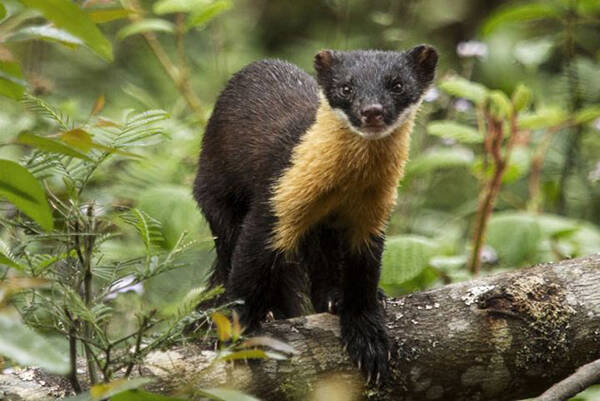Martes gwatkinsii
IUCN
LCBasic Information
Scientific classification
- name:Martes gwatkinsii
- Scientific Name:Martes gwatkinsii,Nilgiri Marten,Gray's marten, Yellow-throated marten Indian subspecies
- Outline:Carnivora
- Family:mustelidae mustelinae marten
Vital signs
- length:About 52 cm
- Weight:About 2kg
- lifetime:8-12年
Feature
It is named for the distinctive yellow-orange throat spot on the front chest.
Distribution and Habitat
The Nilgiri marten is distributed in southern India, the Western Ghats, Karnataka, Kerala and Tamil Nadu.
The Nilgiri marten mainly inhabits various types of forest areas, active in evergreen broad-leaved forests and mixed coniferous broad-leaved forests, large areas of hilly or mountainous forests. It is good at climbing trees and steep rocks and is agile. Most of its nests are built in tree holes or stone caves.
Appearance
The average head and body length of the Nilgiri marten is 52 cm, tail length is 42 cm, and its weight is 2 kg. It is a medium-sized carnivore. It is named after the obvious yellow-orange throat spot on its front chest. The ears are short and round, the tail hair is not fluffy, the body is slender, and the limbs are short. The head is narrow and wedge-shaped, the face is triangular, the ears are generally short and round, and the sense of smell and hearing are sensitive. The canine teeth are more developed and the cleft teeth are smaller; the upper molars are arranged horizontally, and the inner leaves are wider than the outer leaves; the crown diameter of the molars is greater than the height of the outer incisors. This species is similar to the yellow-throated marten, but is larger and the Nilgiri marten has a pink nose. The yellow-throated marten has a black nose. The Nilgiri marten is all black except for the yellow throat and chest. Most of the yellow-throated marten's trunks
Details
Nilgiri Marten (scientific name: Martes gwatkinsii) is a medium-sized carnivore with no subspecies. Before 1992, this species was a subspecies of the yellow-throated marten and was classified as an independent species in 1995.

The Nilgiri marten likes to move at dawn and dusk, but often appears during the day. There are scent glands near the anus that can emit odors to drive away enemies and defend themselves. It is a species with a high sense of territory. Like other martens, the Nilgiri marten uses urine or odor produced from its anal glands to mark paths and divide areas. Male martens will follow these marked paths to patrol their territory.
The Nilgiri marten is a tree-dwelling animal, carnivorous, and mainly feeds on rodents, bird eggs and chicks, fish, and insects.
Listed in the 2015 IUCN Red List of Threatened Species ver 3.1 - Vulnerable (VU).
Protect wild animals and eliminate game.
Maintaining ecological balance is everyone's responsibility!








